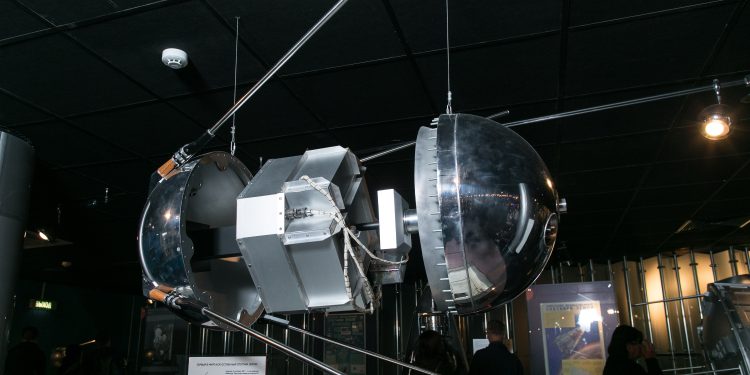In the tense years of the Cold War, the United States and the Soviet Union found themselves locked in a fierce competition, not only on Earth but also in the cosmos.
The launch of Sputnik 1 by the Soviets in 1957 had triggered a space race, but it wasn’t just about reaching the stars. It was also about demonstrating technological prowess and ideological dominance.
In 1958, the world was gripped by fear and anxiety as the Soviet Union successfully launched Sputnik 1, the first artificial satellite. This event marked the height of the Cold War’s Space Race, with the U.S.

The Soviets engaged in a fierce competition, including a nuclear arms race. As the Soviets seemed to be winning the technological race, the United States needed a significant show of strength to boost morale, national confidence, and reestablish its superpower status.
Amid this rivalry, both superpowers considered an audacious plan: to nuke the moon. However, it was the consideration of public opinion that ultimately averted this lunar catastrophe.
The United States and Project A119
In 1958, as the world anxiously watched the Soviets’ space achievements, the United States initiated a secretive project known as “A Study of Lunar Research Flights,” or Project A119.
This top-secret endeavour aimed to investigate the effects of a nuclear explosion on the moon’s surface. It was an audacious plan to nuke the moon by the US.
This project had a seemingly innocuous title but concealed a more aggressive agenda. Its objective: to investigate the visibility and effects of a hypothetical nuclear explosion on the moon’s surface.
From the outset, it was clear that the project had political motivations, aiming to demonstrate America’s advanced weaponry capabilities.
The U.S. Air Force’s goal was clear: a spectacular show of strength that would boost national morale, reassure the American public of their country’s capabilities, and intimidate the Soviet Union.

The Technical Feasibility. The U.S. Air Force believed it was technically feasible to hit a target 238,000 miles away on the moon with an accuracy of within two miles using an intercontinental ballistic missile.
The nuclear device planned for this mission would have been an atom bomb, as a hydrogen bomb would have been too heavy for the missile.
The potential benefits included scientific discoveries about space, nuclear device detection in space, and insights into space warfare capabilities.
Project A119 envisioned placing three identical instruments on the moon’s surface before the detonation.
These instruments would record various measurements before, during, and after the nuclear explosion, providing valuable data about the moon’s composition, environment, and potentially even microbial life.
However, the Scientists involved in this project had their concerns. Led by physicist Leonard Reiffel, the Project A119 involved renowned scientists, including Carl Sagan, a name that would later become synonymous with popular science.
Initially, there were some misconceptions about the possibility of destroying the moon with the nuke. But contrary to these popular misconceptions, the nuclear blast wouldn’t have destroyed the moon.
Reiffel clarified that it would have been microscopic, leaving a crater invisible from Earth, even with a telescope. Nonetheless, even as the team worked on the technical aspects, they couldn’t ignore the ethical and environmental concerns that loomed large.
The potential risks included radioactive contamination of the lunar environment and the dangers of a premature explosion within Earth’s atmosphere.
The Fear of Public Backlash. One of the key considerations that would ultimately shelve Project A119 was the fear of public backlash. Scientists and policymakers understood that the world might not react positively to such a mission.
As Reiffel noted, unless global opinion was well-prepared in advance, a considerable negative reaction could have followed the detonation.
The potential scientific gains had to be weighed against the potential fallout of public opinion.
In a related development, the Soviet Union also had their own plan codenamed Project E-4
Interestingly, the Soviet Union was not far behind in considering a lunar nuclear explosion. They had their own project, codenamed Project E-4, in the works around the same time.
However, the Soviets also grappled with concerns about safety and the propaganda value of such a mission. Ultimately, they decided against proceeding with their lunar nuclear ambitions.
The aftermath was The Outer Space Treaty
In 1967, a significant development occurred. The United States, the Soviet Union, and other nations signed the Outer Space Treaty.
This landmark agreement prohibited the placement of nuclear weapons and other mass destruction weapons in space, including the moon.
It laid down a commitment to using space for peaceful purposes only. This treaty effectively put an end to any future plans of lunar nuclear explosions.
Public Opinion Saved the Moon
Two significant concerns prevented the project from moving forward. First, the fear of radioactive material contaminating the lunar environment posed a significant risk to scientific exploration.
Second, there was the risk of a premature nuclear explosion within Earth’s atmosphere, with devastating consequences.
Even if the mission had succeeded, Reiffel recognized that the public might not have embraced it enthusiastically. The world’s opinion needed to be well-prepared for such an endeavour, or negative reactions could outweigh any potential benefits.
Therefore, in retrospect, it was the consideration of public opinion, both domestically and internationally, that played a pivotal role in preventing the lunar catastrophe.
The scientists and policymakers realized that while they aimed to impress the world, they also risked alienating it.
The fear of negative reactions, coupled with the potential scientific and environmental costs, led to the abandonment of these audacious plans.
The Cold War was marked by intense competition and secrecy, often pushing the boundaries of what seemed possible.
However, the consideration of public sentiment and the broader implications of such actions ultimately prevailed.
The moon, our closest celestial neighbour, was spared from nuclear detonations, and the has world witnessed more peaceful achievements in space exploration till date.
In conclusion, let us note that to this day, many Cold War documents, including detailed information about Project A119, remain classified. Reports written at the time have been destroyed, and government agencies have neither confirmed nor denied the project’s existence, keeping its secrets hidden.











